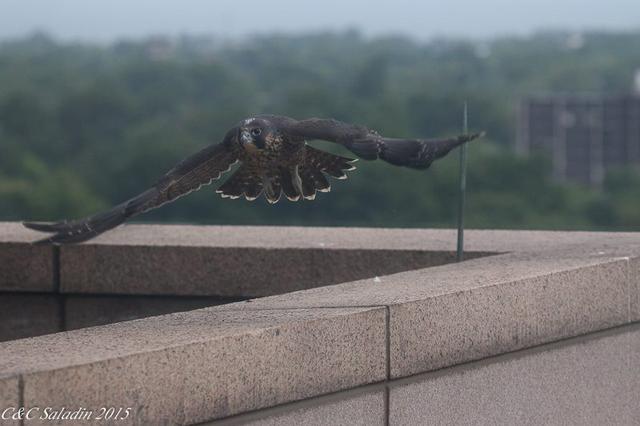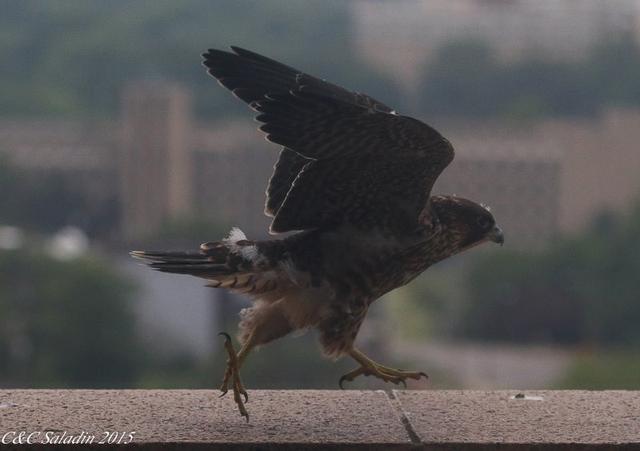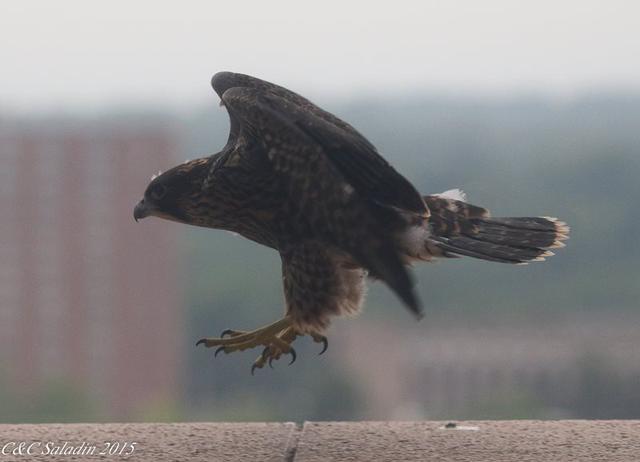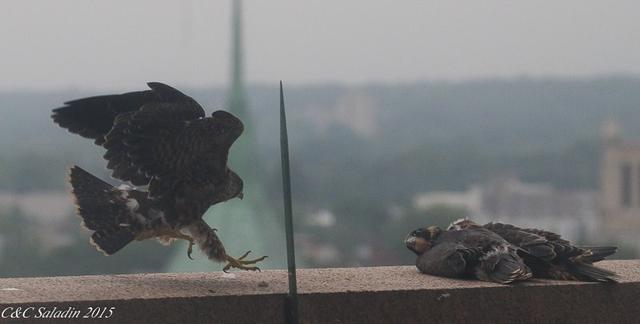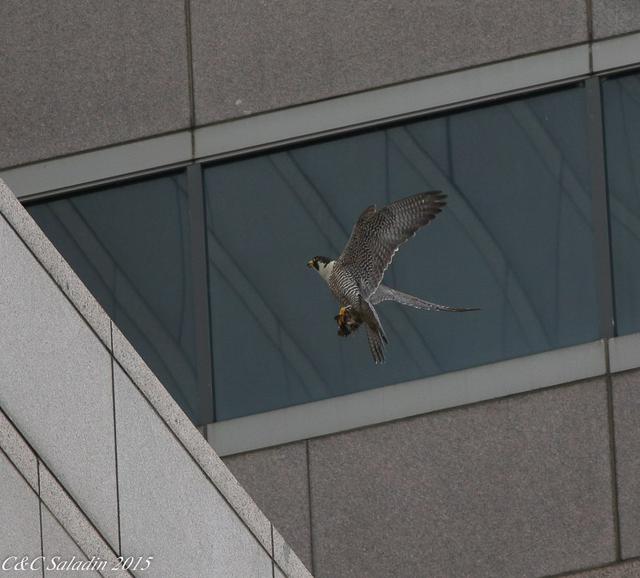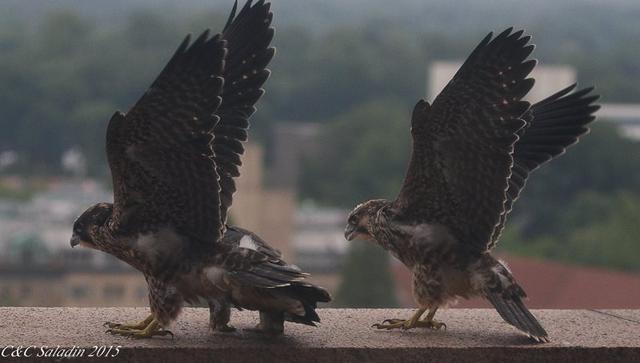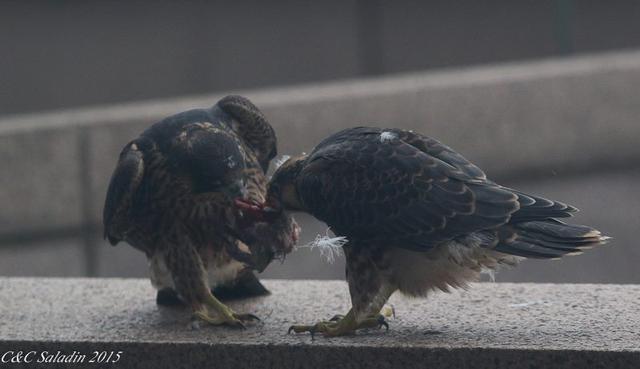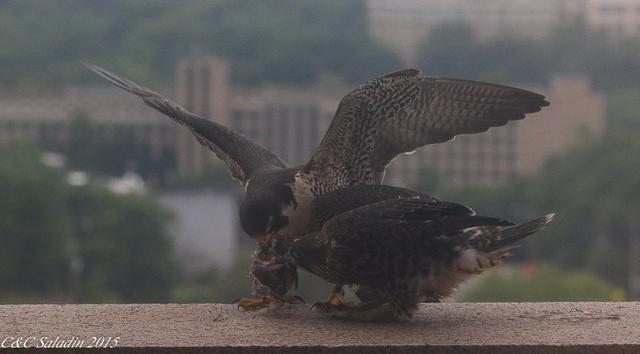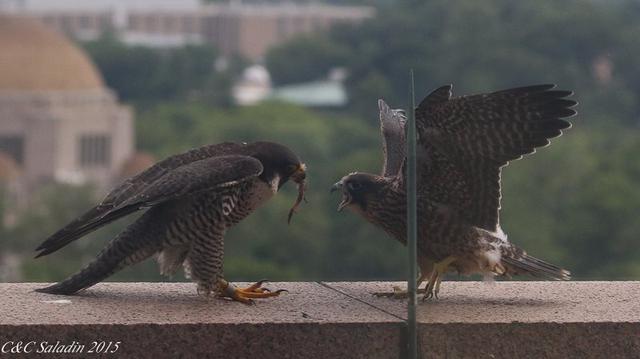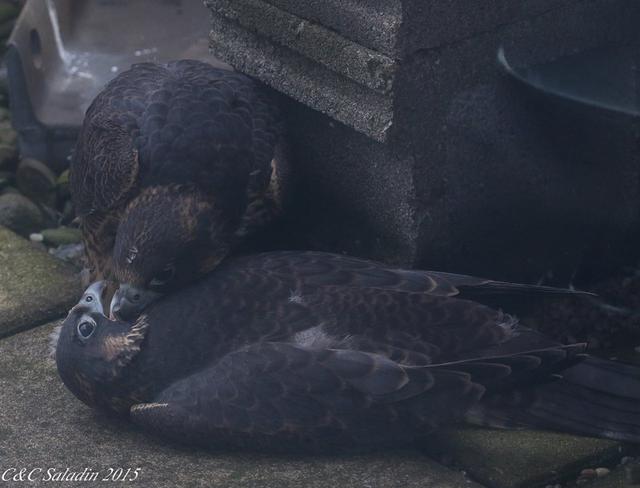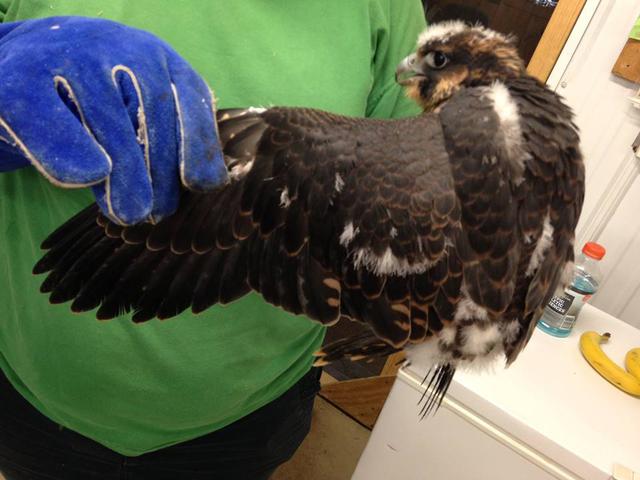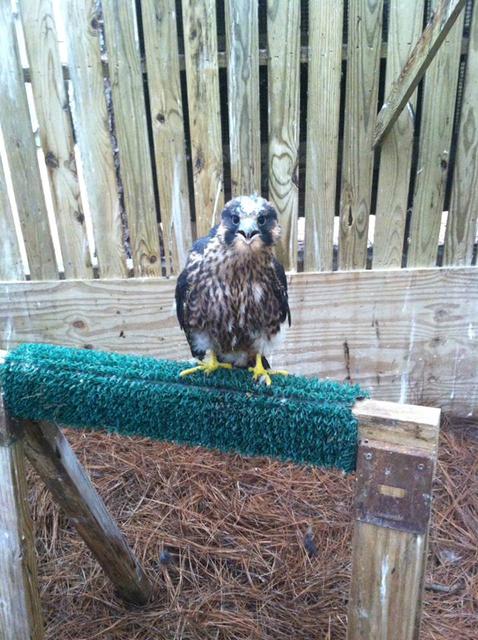FALCON FLASH
Dateline: Cleveland, Ohio
June 15, 2015
Click here to read what happened earlier
But the darker male kept control. Next day at feeding time, Ely brought prey in again, but this time the lighter male beat his siblings to it.
It’s fledge time in Cleveland, when juvenile peregrine falcons are beginning to take their first flights. At Dipper and Ely’s nest at the Cleveland Clinic, a male has taken a successful short flight.
And the juveniles raced to her to get the food……..
There was one final tug of war…..
The darker male got there first and snatched the prey from Ely……
Mr. and Mrs. Saladin tell us, “These interactions show the progression of these juvies that are absorbing so much information to prepare for flight and future survival. The darker juvie likely learned that he has to do a better job of mantling his prey (where a raptor blocks the prey by flaring their wings at the shoulders and huddling over the food) if he doesn't want it to be potentially stolen in the future. On the next day this same juvie knew to go to mom as the food source over challenging his sibling, despite the fact that the sibling had a full bird and mom just had a leg. And yet meanwhile, they continue to "act like kids", playfully interacting and beak touching, demonstrating the very social nature of the peregrine that has also been developing from early on when they were newly hatched eyasses, huddling together for warmth”.
All this exercise, plus enormous growth, requires LOTS of food. The Canadian Peregrine Foundation tells us: “Peregrines, as well as many other predatory species, can eat large quantities of food in one sitting, which is to their advantage because they never know when they will get their next meal. Peregrines can,
in one sitting, eat a meal weighing as much as one quarter of their own weight. Additional food is usually stored in caches to be returned to at a later time when fresh food is scarce. A typical Peregrine family (2 adults and 3 young) eats roughly 225 kilograms (500 pounds) of food per year.”
Mr. and Mrs. Saladin recently saw 2 different and interesting feedings. At the first feeding, Ely brought prey up to a balcony ledge…….
The lighter male sibling followed and tried to pull the prey away…….
but the darker one kept the prey and then ran away.
It was a short 10 foot flight, which was a good idea. Sara Jean Peters, of the Ohio Division of Wildlife (retired) tells us: “Like children learning to walk, flight is a series of experiments...some successful, some not. Chicks typically exercise their wings, flapping in place, hopping and flapping, and running and flapping. If their nest is on a cliff, updrafts can actually catch under the extended wings and lift
the birds up into the air and to a higher ledge. There are updrafts in the city as well, although the ledges aren't as numerous. A chick that flushes from the ledge and takes flight too early may end up on the ground...a risky place in the city as well as at the foot of a cliff. It takes more muscle power to fly UP than out. Muscle development comes with age and exercise. The first flight made by an older chick will probably be more successful than that made by a younger chick. Landings, a very important part of flights, take lots of practice regardless of age!”
Ely and Dipper’s youngsters are about 40 days old, and they are working hard to strengthen their wings and muscles. Flapping, hopping and running on the building ledges is fast and furious as fledging draws near.
Wise mother Ely was watching what happened and she decided to find and pick up a little piece of prey. When the darker male who didn’t have the food saw this, instead of challenging his sibling who had the full prey, he went to his mother for a small bit of food.
All 3 of Ely and Dipper’s chicks will soon be flying.
Meanwhile, back at the river, Phelps, the famous swimming chick, proved he has strong wings as he was able to “fly” though the water to shore after falling off the bridge. After he was rescued, he was checked out and fed at the Medina Raptor Center, and then Mr. and Mrs. Saladin and several helpers attempted
to put him back in his nestbox. His parents were very upset and loudly “kekking” their alarm call which you can hear as you watch the following video showing Mr. and Mrs. Saladin putting Phelps back out on the bridge: https://www.youtube.com/watch?v=zN70J-JyXJ4
Just after the video ended, Phelps, who was probably very scared as he listened to his parents alarm calls, took another misstep and down he went into the river again! Mr. and Mrs. S rescued him, and once again, he was checked out and he is fine!
Phelps is temporarily staying at the Medina Raptor Center and he won't be released until he is "flight ready" and until after his two siblings have fledged. Mrs. Saladin reports, “…… he's now in a cage where he is able to use his wings, hop-flap, ladder up, and jump up to higher perches. Checked on his siblings today and they are flapping strongly on the porch, but still sport more down than Phelps. Thanks to
Laura Cooper Jordan and the MRC staff for the fantastic work! Can't wait for Phelps to go back home!”
To learn more about the Medina Raptor Center visit: http://www.medinaraptorcenter.org/
Stay tuned for more fledging news……….
Photos are courtesy of Mr. and Mrs. Saladin, volunteer peregrine nest monitors. Video is courtesy of Share the River.
Click here to read what happened next


